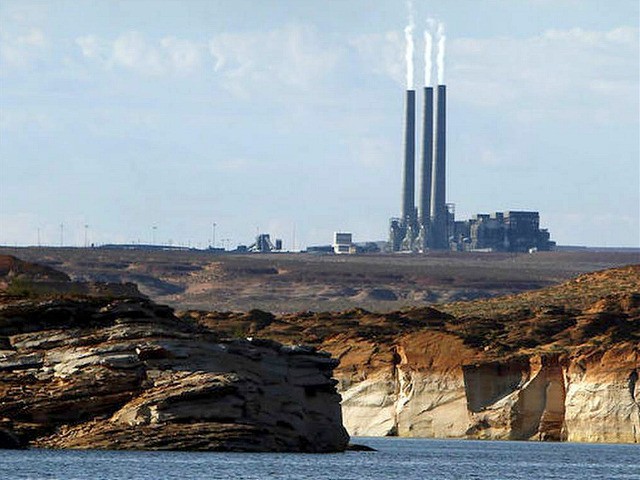Headlines in recent years have pitted Native Americans against the production of domestic energy infrastructure such as oil and gas pipelines that they claim harms their lands. But for the Hopi and Navajo tribes in northeastern Arizona, the shuttering of a strip coal mine and power plant has left tribe members without a source of heat in the winter as well as year-round revenue.
Left-wing and taxpayer-funded National Public Radio (NPR) reported on the Hopi tribe’s challenges now that the coal mine is closed:
Many are cheering the closure of a giant coal strip mine in Arizona, but thousands of Native Americans who burn coal for heat are scrambling. Alternative heat sources are scarce and expensive.
Before the mine closed, it provided free coal to many tribal members. Chelsea Sekakuku of Kykotsmovi Village says she now has to get up twice a night to add wood to her coal stove. It takes Sekakuku and her three children a full day to gather a truckload of wood, which only lasts one week.
“It’s just a lot of physical work,” Sekakuku said in the NPR report. “And, you know, not everyone is able to afford wood, but it’s a necessity now.”
Despite the left’s agenda to shut down all fossil fuel production in the United States, including coal, to stop so-called manmade climate change, these energy resources have improved the lives of people around the globe, including Native Americans.
An article in the Navajo-Hopi Observer posted on March 27th, 2018, filled in some of the details omitted from the NPR article, including naming the Kayenta Mine and the Navajo Generating Station:
For 50 years, the Kayenta Mine on Black Mesa has supplied coal to fire the Navajo Generating Station (NGS), which powers Phoenix air conditioners, Las Vegas Strip neon and California Teslas.
With coal falling out of favor nationally, the power station is set to close in 2019 and along with it the mine. The mine and power station provide hundreds of well-paying jobs for members of the Hopi and Navajo nations and mining royalties account for nearly 75 percent of the Hopi Tribe’s budget.
AZCentral provided more details on how much the mine and power plant benefited Native Americans and how the changing energy landscape would eventually harm them in a story from 2017:
Together, the mine and the power plant employ 750 workers, nearly all Native Americans living on the two reservations, where unemployment approaches 50 percent. The operations support communities from Tuba City, a small enclave 60 miles west of the mine, with a grocery store, banks and a few hotels, to the non-reservation city of Page on the shore of Lake Powell and the Navajo town of Kayenta, with about 5,000 people. But because there are cheaper alternatives for making electricity, the power plant’s owners voted to close it in two years.
If the generating station closes, the mine loses its only customer. It, too, will close.
After spending years on expensive negotiations with the Environmental Protection Agency to keep the coal plant open, four of the five owners — Salt River Project, Arizona Public Service Co., Tucson Electric Power and NV Energy — decided in early February to give up the fight. This time, the issue is not carbon emissions or haze at the Grand Canyon. It is economics. The utilities can get cheaper power from natural-gas-powered plants, saving each owner millions of dollars per year. The fifth owner, the U.S. Bureau of Reclamation, uses its share to power the pumps on the canal and pay off debt from its construction. The agency wants to keep the facilities open but can’t foot the bill for the entire plant.
But the closure of the mine and power plant is really the end of the relationship between Native Americans and coal that goes back centuries, according to a New Mexico Geological Society’s 1958 paper:
The coal produced from the Black Mesa field is utilized for both domestic and power-house requirements. Before the introduction of natural gas to northern Arizona in 1951, some coal was produced to supply the needs of Holbrook, Winslow, and Flagstaff. In addition to the commercial mines, there are a great many small open mines on Black Mesa which are worked by the Navajo and Hopi Indians for their own use.
There was considerable use of coal by the Hopi Indians in prehistoric time. Coal ash has been found in kivas, primitive stone stoves, and pottery firing pits dating back at least to the year 1300 A.D. This indicates that the Hopi Indians were burning coal before it came into general use in Europe. Brew and Hack estimate that over 100,000 tons of coal were produced in Jeddito Valley in the years 1300 to 1600. This figure is greater than the total recorded production for Arizona in the years 1926-1946.
NPR’s report painted a grim picture for the Hopi tribe today, according to Clark Tenakhongva, vice chairman of the tribe.
“He says this winter, many must choose between eating and keeping warm,” NPR reported.
Follow Penny Starr on Twitter.

COMMENTS
Please let us know if you're having issues with commenting.